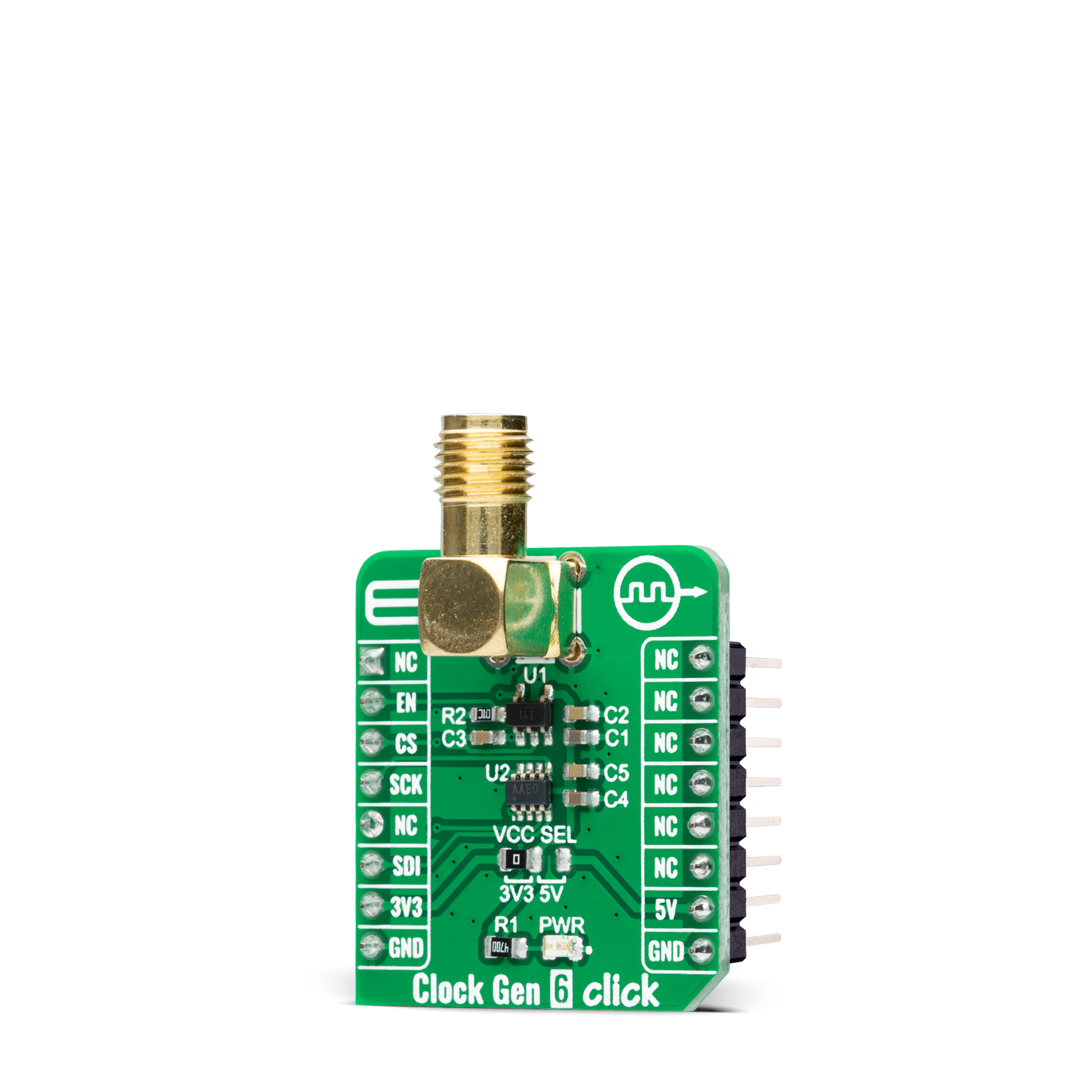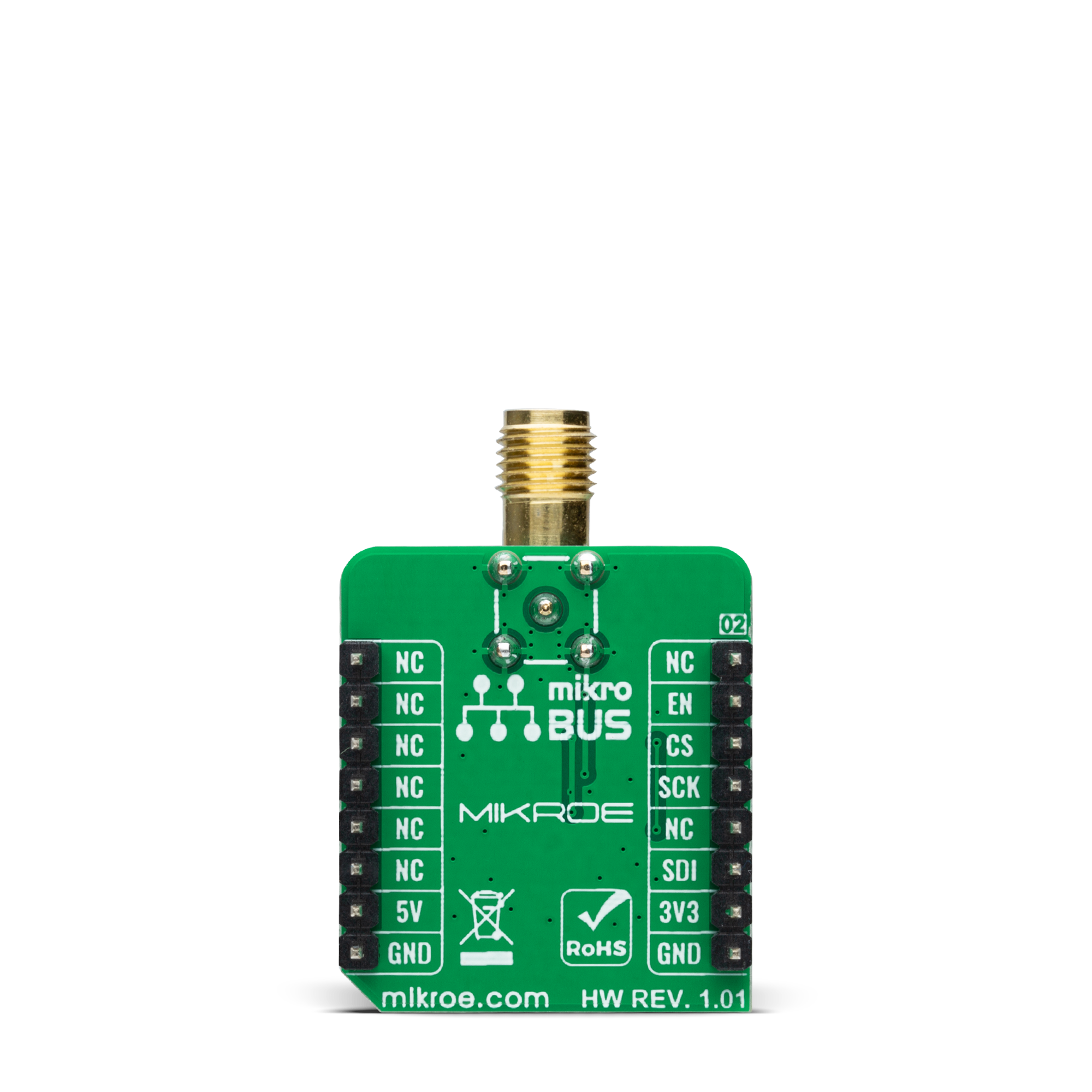IttyBitty CMOS RC oscillator designed to provide rail-to-rail pulses for precise time delay or frequency generation
A
A
Hardware Overview
How does it work?
Clock Gen 6 Click is based on the MIC1557, a low-power digital frequency solution providing the logic for creating a simple RC oscillator circuit from Microchip Technology. The MIC1557 offers rail-to-rail pulses for precise frequency generation alongside a single threshold and trigger connection, internally connected, for astable (oscillator) operation only with programmable output frequency and enable/reset control signal intended as an oscillator with a Shutdown capability. As mentioned, the astable oscillator switches between two states, ON and OFF, producing a continuous square wave. The MIC1557 is optimized for this function by tying the two comparator inputs together, the threshold, and trigger pins (THR and TRG), forming a T/T pin.
The external capacitor charges slowly through the external resistor in the form of a digital potentiometer by which the user can pass through the frequency range and thus adjust the desired output. Replacing the resistor with a digital potentiometer allows the user to program frequency output as performed on this Click board™. For this purpose, the digital potentiometer MAX5401, which communicates with the MCU via a 3-Wire SPI serial interface, is used to set the resistance on the MIC1557 OUT line, adjusting the frequency up to 5MHz. Alongside SPI communication, this Click board™ also uses one additional pin. The Enable pin, labeled as EN and routed to the RST pin of the mikroBUS™ socket, optimizes power consumption and is used for power ON/OFF purposes
(controls the bias supply to the oscillator’s internal circuitry). When the MIC1557 is deselected, the supply current is less than 1μA, and the device is placed in a Shutdown state. Forcing the EN pin low resets the device by setting the flip flop, causing the output to a low logic state. This Click board™ can operate with either 3.3V or 5V logic voltage levels selected via the VCC SEL jumper. This way, both 3.3V and 5V capable MCUs can use the communication lines properly. However, the Click board™ comes equipped with a library containing easy-to-use functions and an example code that can be used, as a reference, for further development.



Features overview
Development board
Arduino UNO is a versatile microcontroller board built around the ATmega328P chip. It offers extensive connectivity options for various projects, featuring 14 digital input/output pins, six of which are PWM-capable, along with six analog inputs. Its core components include a 16MHz ceramic resonator, a USB connection, a power jack, an
ICSP header, and a reset button, providing everything necessary to power and program the board. The Uno is ready to go, whether connected to a computer via USB or powered by an AC-to-DC adapter or battery. As the first USB Arduino board, it serves as the benchmark for the Arduino platform, with "Uno" symbolizing its status as the
first in a series. This name choice, meaning "one" in Italian, commemorates the launch of Arduino Software (IDE) 1.0. Initially introduced alongside version 1.0 of the Arduino Software (IDE), the Uno has since become the foundational model for subsequent Arduino releases, embodying the platform's evolution.
Microcontroller Overview
MCU Card / MCU

Architecture
AVR
MCU Memory (KB)
32
Silicon Vendor
Microchip
Pin count
28
RAM (Bytes)
2048
You complete me!
Accessories
Click Shield for Arduino UNO has two proprietary mikroBUS™ sockets, allowing all the Click board™ devices to be interfaced with the Arduino UNO board without effort. The Arduino Uno, a microcontroller board based on the ATmega328P, provides an affordable and flexible way for users to try out new concepts and build prototypes with the ATmega328P microcontroller from various combinations of performance, power consumption, and features. The Arduino Uno has 14 digital input/output pins (of which six can be used as PWM outputs), six analog inputs, a 16 MHz ceramic resonator (CSTCE16M0V53-R0), a USB connection, a power jack, an ICSP header, and reset button. Most of the ATmega328P microcontroller pins are brought to the IO pins on the left and right edge of the board, which are then connected to two existing mikroBUS™ sockets. This Click Shield also has several switches that perform functions such as selecting the logic levels of analog signals on mikroBUS™ sockets and selecting logic voltage levels of the mikroBUS™ sockets themselves. Besides, the user is offered the possibility of using any Click board™ with the help of existing bidirectional level-shifting voltage translators, regardless of whether the Click board™ operates at a 3.3V or 5V logic voltage level. Once you connect the Arduino UNO board with our Click Shield for Arduino UNO, you can access hundreds of Click boards™, working with 3.3V or 5V logic voltage levels.
Used MCU Pins
mikroBUS™ mapper
Take a closer look
Click board™ Schematic

Step by step
Project assembly
Track your results in real time
Application Output
1. Application Output - In Debug mode, the 'Application Output' window enables real-time data monitoring, offering direct insight into execution results. Ensure proper data display by configuring the environment correctly using the provided tutorial.

2. UART Terminal - Use the UART Terminal to monitor data transmission via a USB to UART converter, allowing direct communication between the Click board™ and your development system. Configure the baud rate and other serial settings according to your project's requirements to ensure proper functionality. For step-by-step setup instructions, refer to the provided tutorial.

3. Plot Output - The Plot feature offers a powerful way to visualize real-time sensor data, enabling trend analysis, debugging, and comparison of multiple data points. To set it up correctly, follow the provided tutorial, which includes a step-by-step example of using the Plot feature to display Click board™ readings. To use the Plot feature in your code, use the function: plot(*insert_graph_name*, variable_name);. This is a general format, and it is up to the user to replace 'insert_graph_name' with the actual graph name and 'variable_name' with the parameter to be displayed.

Software Support
Library Description
This library contains API for Clock Gen 6 Click driver.
Key functions:
clockgen6_set_digipotThis function sets the digital potentiometer position by using SPI serial interface.clockgen6_enable_outputThis function enables the output by setting the EN pin to high logic state.clockgen6_disable_outputThis function disables the output by setting the EN pin to low logic state.
Open Source
Code example
The complete application code and a ready-to-use project are available through the NECTO Studio Package Manager for direct installation in the NECTO Studio. The application code can also be found on the MIKROE GitHub account.
/*!
* @file main.c
* @brief Clock Gen 6 Click Example.
*
* # Description
* This example demonstrates the use of Clock Gen 6 Click board which acts as
* an astable oscillator.
*
* The demo application is composed of two sections :
*
* ## Application Init
* Initializes the driver and performs the Click default configuration which sets the digital
* potentiometer to max position and enables the clock output.
*
* ## Application Task
* Changes the clock output frequency by changing the digital potentiometer position every second.
* The potentiometer position value will be displayed on the USB UART.
*
* @author Stefan Filipovic
*
*/
#include "board.h"
#include "log.h"
#include "clockgen6.h"
static clockgen6_t clockgen6; /**< Clock Gen 6 Click driver object. */
static log_t logger; /**< Logger object. */
void application_init ( void )
{
log_cfg_t log_cfg; /**< Logger config object. */
clockgen6_cfg_t clockgen6_cfg; /**< Click config object. */
/**
* Logger initialization.
* Default baud rate: 115200
* Default log level: LOG_LEVEL_DEBUG
* @note If USB_UART_RX and USB_UART_TX
* are defined as HAL_PIN_NC, you will
* need to define them manually for log to work.
* See @b LOG_MAP_USB_UART macro definition for detailed explanation.
*/
LOG_MAP_USB_UART( log_cfg );
log_init( &logger, &log_cfg );
log_info( &logger, " Application Init " );
// Click initialization.
clockgen6_cfg_setup( &clockgen6_cfg );
CLOCKGEN6_MAP_MIKROBUS( clockgen6_cfg, MIKROBUS_1 );
if ( DIGITAL_OUT_UNSUPPORTED_PIN == clockgen6_init( &clockgen6, &clockgen6_cfg ) )
{
log_error( &logger, " Communication init." );
for ( ; ; );
}
if ( CLOCKGEN6_ERROR == clockgen6_default_cfg ( &clockgen6 ) )
{
log_error( &logger, " Default configuration." );
for ( ; ; );
}
log_info( &logger, " Application Task " );
}
void application_task ( void )
{
for ( int16_t pos = CLOCKGEN6_DIGIPOT_POSITION_MAX; pos >= CLOCKGEN6_DIGIPOT_POSITION_MIN; )
{
if ( CLOCKGEN6_OK == clockgen6_set_digipot ( &clockgen6, pos ) )
{
log_printf( &logger, " DIGIPOT position: %u\r\n", pos );
Delay_ms ( 1000 );
pos -= 5;
}
}
}
int main ( void )
{
/* Do not remove this line or clock might not be set correctly. */
#ifdef PREINIT_SUPPORTED
preinit();
#endif
application_init( );
for ( ; ; )
{
application_task( );
}
return 0;
}
// ------------------------------------------------------------------------ END
Additional Support
Resources
Category:Clock generator

































